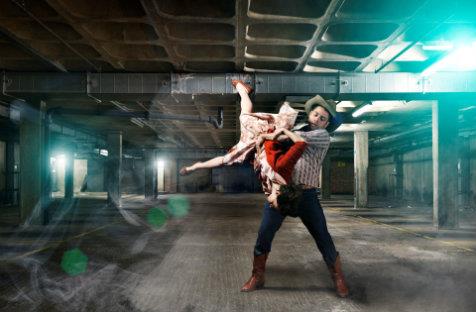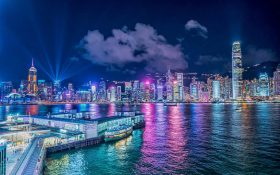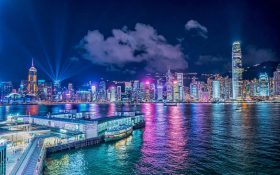Two narratives of desperate love, betrayal and revenge mirror each other in their respective settings inside and outside of Temple Studios, a factory of dreams in the manner of the powerful Hollywood studios of the 1940s. Numerous subplots weave their ways in and out of the main action, following supporting characters in their own small dramas of ambition in seeking fame, fortune and love.
The Drowned Man sees a multi-storey building transformed into not only the various studio sets of Temple Studios, but also into the hard-living, unforgiving world of grim struggle outside its gates. The large cast sees all members working hard as they are constantly ‘on’, even when ducking into a room for a costume change. Audience members are introduced into the world of the performance in small groups, each person issued with a beaked white mask and the instruction to remain masked and silent, unless in the bar area. Audience are then let loose to explore the set, follow particular cast members or simply to hang out in the well-stocked bar and listen to live music and be entertained by an illusionist.
The dim lighting of the warren-like interior lent an air of foreboding, enhanced by the weirdly silent faceless forms drifting in and out of the various sets and scenes. When audience members threatened to intrude on a performance area, they were either gently headed off by black garbed, masked assistants, or the actors added moves to the formal choreography to clear the space using only body language and incidental contact, such as the light tap of a photograph across the nose of a too-inquisitive mask.
The nature of the building and of the show precluded air conditioning, so from the muggy closeness of summer through to the middle of winter, the cast commit themselves not only to high intensity repeated dance routines that saw some heavily suited cast members soaked with sweat through three layers of clothing, but also to naked immersions in bodies of water while holding still, the counterpoint to slow dance moves by other performers. With some of these scenes repeated at various points throughout each performance, as vignettes that tie into the interwoven web of intersecting storylines, performer commitment and stamina were particularly impressive.
The high quality of each performance within The Drowned Man created frustration at the impossibility of seeing everything in a single attendance. Some audience members seemed on a mission to examine each detailed nook and cranny of the set – while they may have succeeded, it could only have been at the expense of witnessing dazzlingly tight choreography and the building of intricate dramatic story arcs, each in turn linking to other narratives. Similarly, by doggedly sticking to one character and following them around the building, richly developed subplots could be unravelled, but as characters interacted with each other, various routines were repeated in different contexts. The repetition usefully gave audience members a chance to follow a variety of characters in their progress, but also meant that returning to a previous part of the set risked going back on one’s own narrative tail.
The extension of the show’s run to the end of the year widens the reach of this spectacular work to both new audiences and those who have found, after babbling excitedly with their friends after the finale, that there were yet more staircases to climb or descend. The Drowned Man takes immersive performance to new levels of scale, narrative intricacy, set complexity, performer talent and atmospheric consistency.
Rating: 5 stars out of 5
The Drowned Man: A Hollywood Fable
Presented by Punchdrunk and the National Theatre
Directed by Felix Barrett and Maxine Doyle
Designers: Felix Barrett, Livi Vaughan and Beatrice Minns
Choreographer: Maxine Doyle
Lighting Designer: Mike Gunning
Sound Designer: Stephen Dobbie
Costume Designer: Jack Galloway
Composer: Magnus Fiennes
Illusionist: John van der Put
Temple Studios, 31 London Street, W2 1DJ, London
9 July – 31 December





